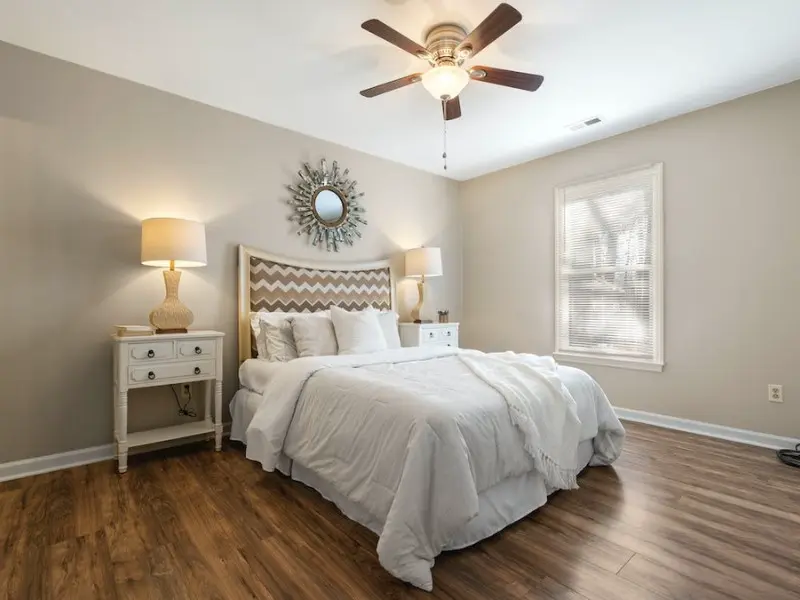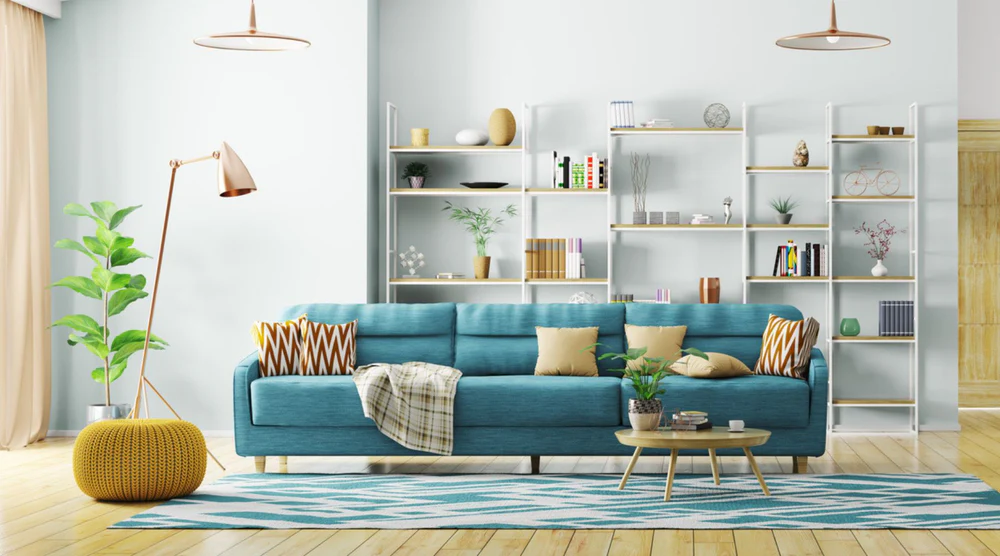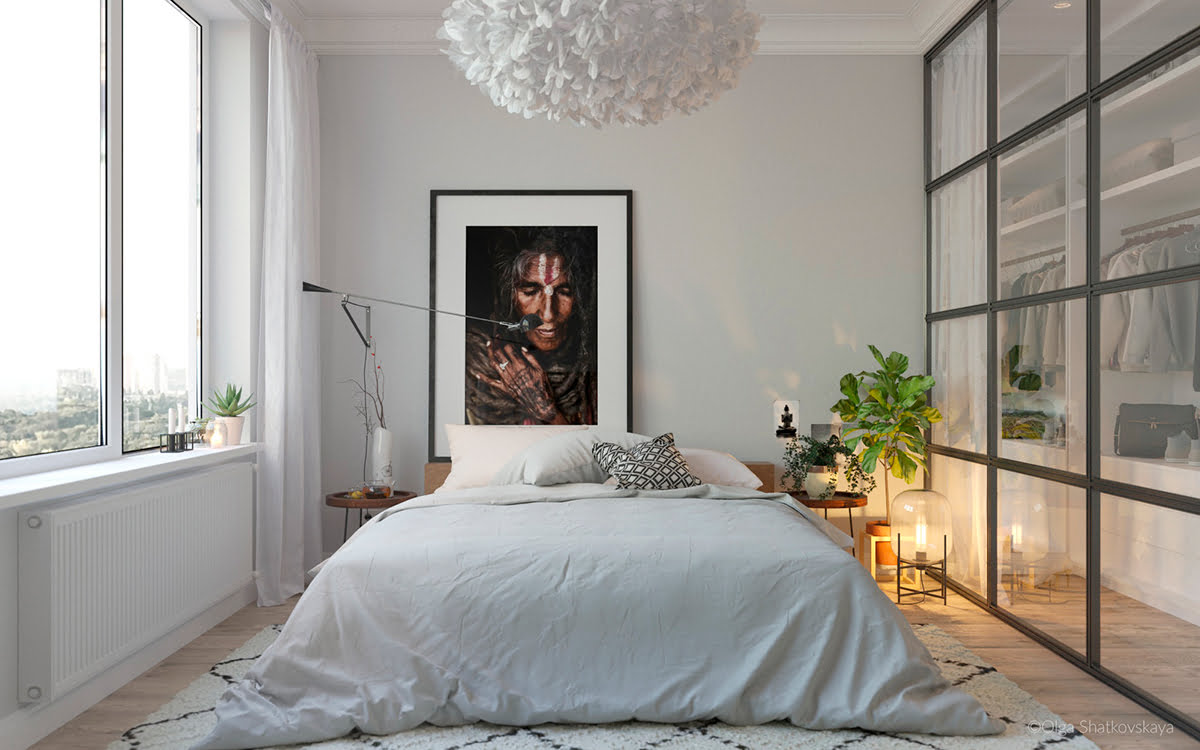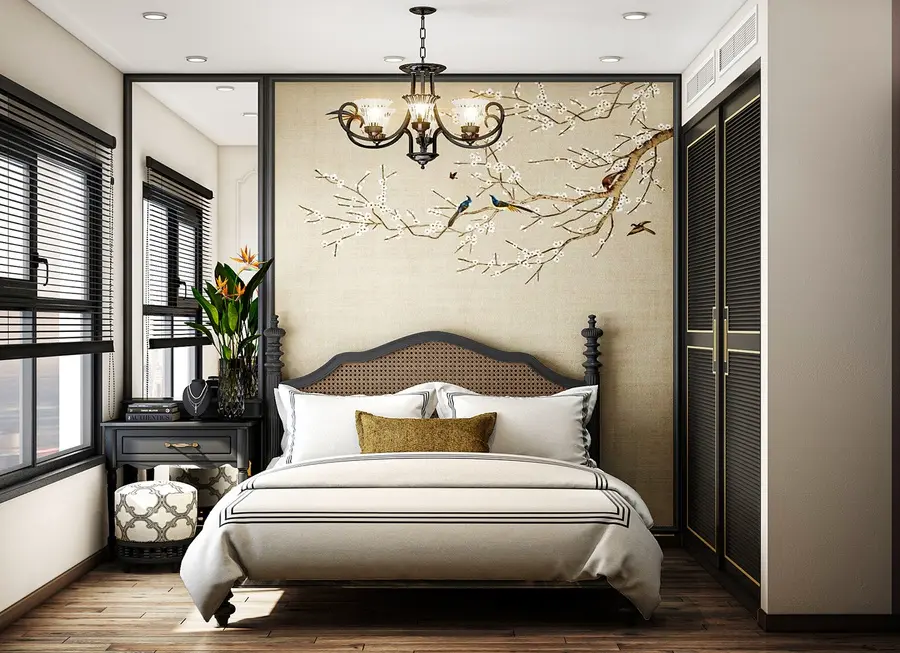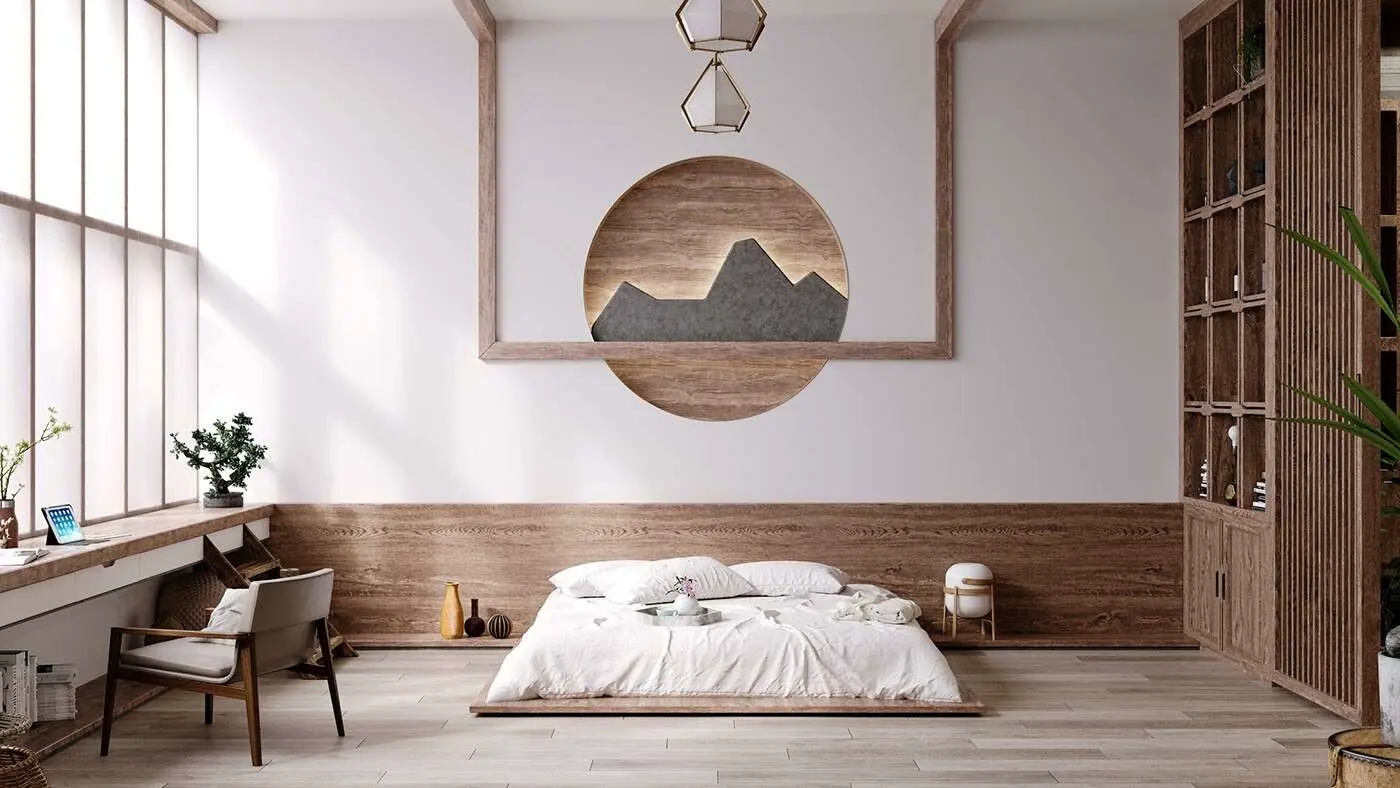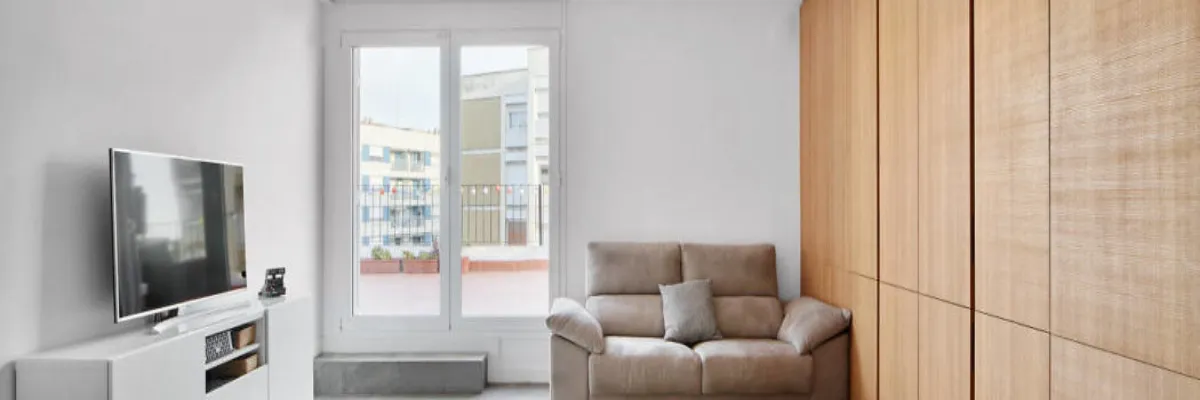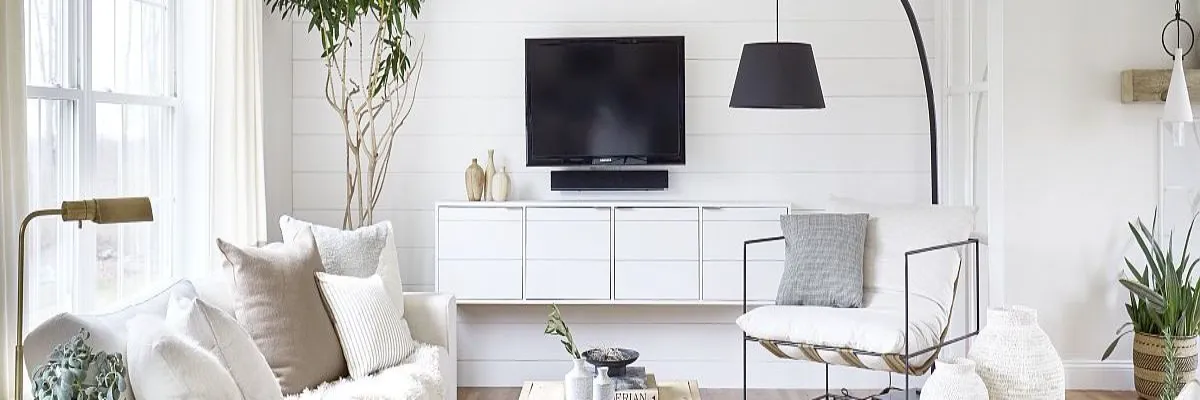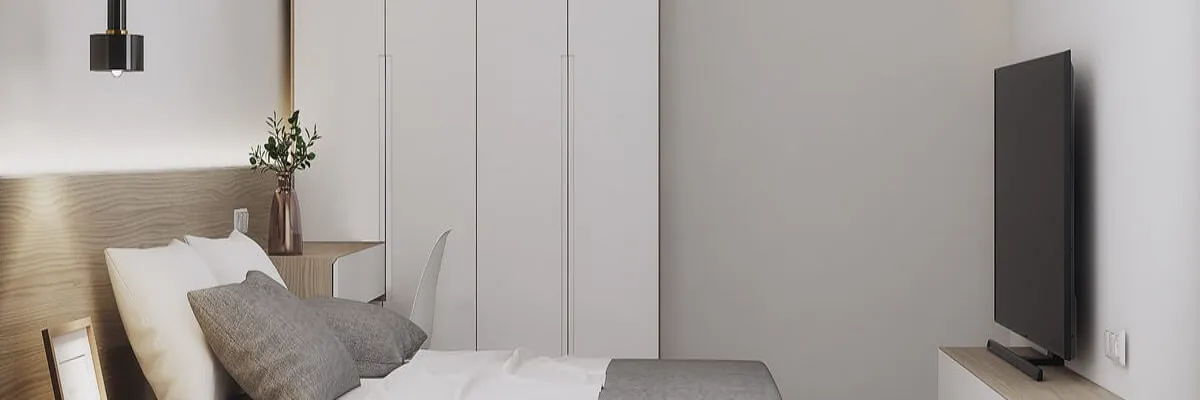mục lục
Minimalist design for living room is gaining traction in 2024 as a popular trend in interior decoration. Embracing minimalism brings about an aura of elegance and comfort, creating an expansive and intelligently arranged space where the living room serves as the hub for family interaction and convergence. Join AIC JSC in exploring the latest ideas and approaches for minimalist living rooms in 2024
1. The concept of minimalist design
Minimalist design is a design philosophy that prioritizes simplicity, functionality, and the utilization of essential elements. Originating as an art movement in the early 20th century, it has since transcended various disciplines, including interior design, architecture, product design, and graphic design.
This design approach often defies fleeting trends, maintaining its relevance and allure over time. Its emphasis on simplicity, functionality, and quality ensures enduring aesthetic appeal.
Beyond aesthetics, minimalist spaces have a profound impact on well-being, promoting a sense of calm and reducing stress and anxiety. By minimizing clutter and emphasizing natural elements, they foster peace, tranquility, and overall wellness.
2. The core principles you should know about minimalist design for living room
Central to minimalist ideology is the notion of minimizing visual clutter. This entails making deliberate choices regarding furniture, decor, and overall design elements. The aim is to cultivate a space that exudes cleanliness, tidiness, and intentionality.
Moreover, Neutral Color Palette often serves as the cornerstone of minimalist design. Neutral Color Palette is commonly employed to instill a sense of serenity and expansiveness in the living room. While neutrals predominantly dictate the ambiance, sporadic pops of color can be introduced through accent pieces or organic accents to inject visual intrigue.
Furthermore, Clean Lines are imperative for achieving the desired minimalist aesthetic. Furniture characterized by sleek silhouettes and unblemished surfaces plays a pivotal role in maintaining simplicity and coherence within the space. Steer clear of excessively ornate or cumbersome pieces that could potentially inundate the room. The crisp, unadorned lines contribute significantly to the overall sense of refinement and lucidity inherent in minimalist design.
Lastly, it’s imperative to prioritize Quality over Quantity. Rather than inundating the living room with an excess of items, it’s advisable to invest in a select few high-quality, enduring pieces. This not only reinforces the minimalist aesthetic but also guarantees durability and sustainability in design choices. By prioritizing quality over quantity, one can curate a space that feels deliberate, refined, and thoughtfully composed.
3. Applying these principles to the minimalist design for living room
3.1 Utilizing Neutral Color Palettes as the Dominant Theme:
Choose neutral color palettes such as white, beige, and light gray as the dominant hues for walls, ceilings, and floors. These colors create a sense of spaciousness, openness, and bring elegance and lightness to the space. Complement these neutral tones with 1-2 contrasting or supplementary accent colors to create focal points in the room, such as blue, green, yellow, or orange.
However, avoid using too many colors in the same space, as it can make the room visually cluttered and detract from the minimalist beauty. Stick to hues that are relatively similar in brightness to maintain overall harmony in the design. For example:
Use light gray tones for walls and ceilings, combined with neutral colors like white and beige for furniture and decor.

Light gray with other neutral tones.
Use beige tones for walls and ceilings, paired with natural wood furniture such as oak or walnut.
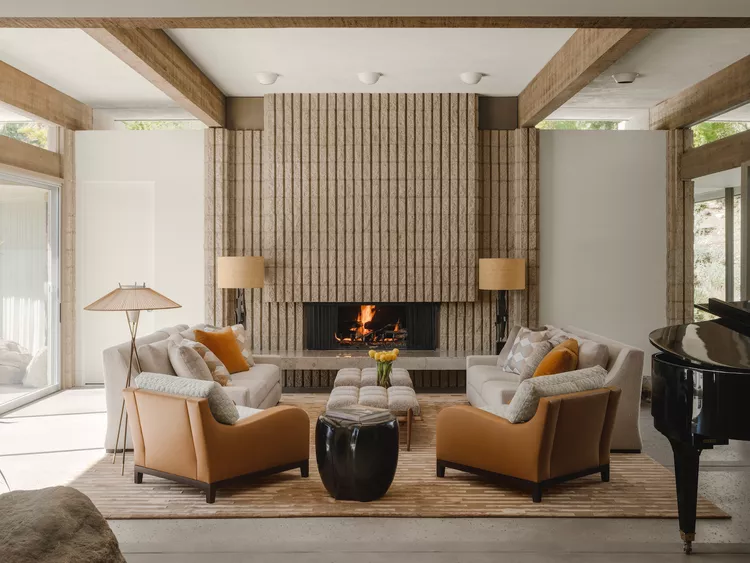
Living room with beige walls and natural wood tones.
Incorporate accent colors like blue, green, yellow, or orange in materials and decorative accessories, but ensure they have a similar brightness level to the dominant neutral hues.

Living room with contrasting accent colors while maintaining harmony.
3.2 Utilizing natural materials:
Utilizing natural materials such as wood, stone, and metal can serve as exquisite focal points for various details within the living room, including the flooring, walls, ceiling, and furniture. These natural elements often exude an aura of sophistication and refinement, elevating the ambiance of the space. This harmonious blend creates a sense of unity and opulence, imparting a cohesive and luxurious feel to the living room.

Utilizing natural materials such as wood, stone, and metal
3.3 Harnessing natural light and employing warm-toned artificial lighting:
In minimalist design for living room design, harnessing natural light plays a pivotal role. Incorporating large windows allows ample natural light to flood the room, fostering a sense of openness and connection with the outdoors. Moreover, opting for sheer curtains enables precise control over light levels, offering flexibility to tailor the ambiance according to specific needs while maintaining a seamless integration with the space.
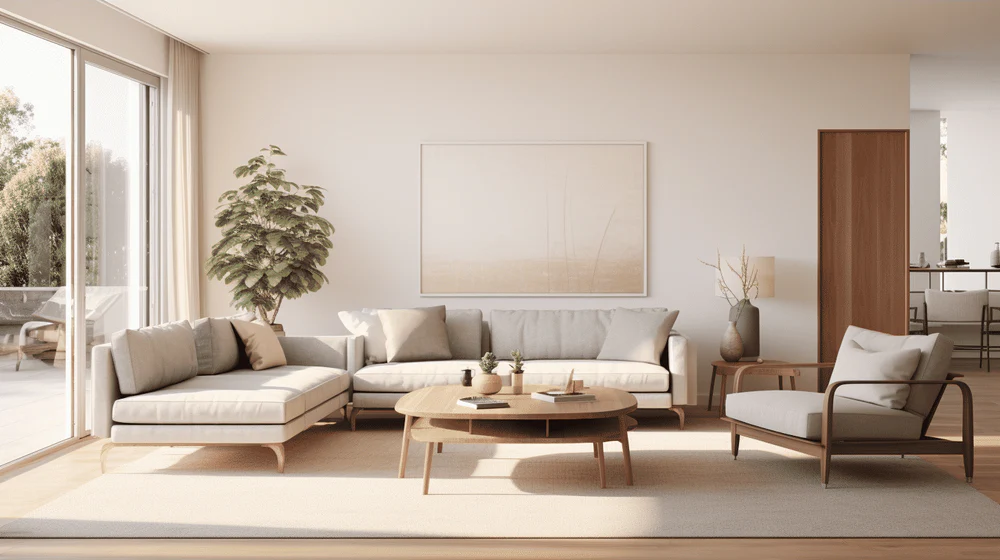 Beyond leveraging natural light, artificial lighting choices are equally paramount. Recessed LED lights and floor lamps should emit warm-toned hues, fostering a cozy and relaxing atmosphere. Avoiding overly harsh lighting not only safeguards eye health but also ensures the living room remains inviting and comfortable. Seamless transitions between natural and artificial light sources further enhance the overall aesthetic appeal, creating a harmonious and tranquil environment conducive to relaxation and socializing.
Beyond leveraging natural light, artificial lighting choices are equally paramount. Recessed LED lights and floor lamps should emit warm-toned hues, fostering a cozy and relaxing atmosphere. Avoiding overly harsh lighting not only safeguards eye health but also ensures the living room remains inviting and comfortable. Seamless transitions between natural and artificial light sources further enhance the overall aesthetic appeal, creating a harmonious and tranquil environment conducive to relaxation and socializing.
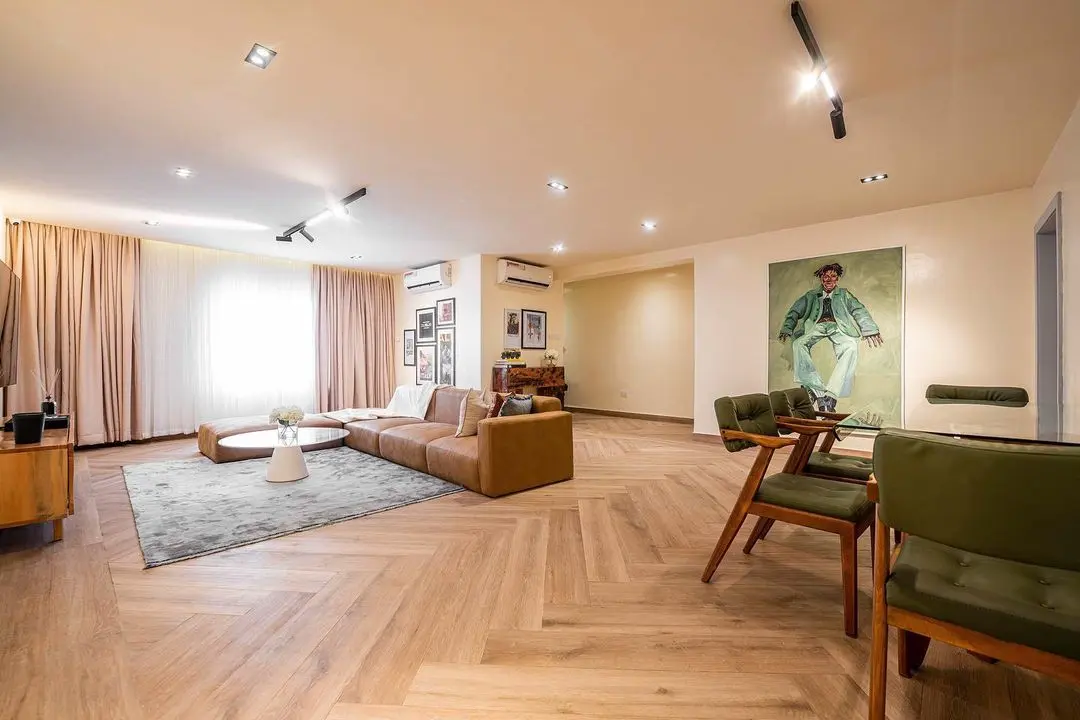
3.4 Limiting the Use of Ornate Decor:
In the principle of minimalist design for living room, restricting ornate decorations and focusing on essential details is crucial. Instead of overcrowding the space, we should concentrate on necessary items such as artworks, vases of flowers, and lamps to create focal points and highlight the space. Decorative items should be carefully chosen with simple, elegant designs that complement the overall style of the room. The use of greenery not only brings fresh air but also creates a natural connection. Avoid overloading the space by keeping the amount of decor to a minimum, helping maintain openness and harmony.

3.5 Prioritize the Use of Simple, Neat Furniture.
Utilizing simple, tidy furniture with high functionality is the key to minimalist design for living room. This approach ensures that each item contributes meaningfully to the space without overwhelming it. Prioritizing multifunctional furniture is essential, as it maximizes utility while minimizing the need for excessive pieces. Examples include sofa beds or storage ottomans, which serve multiple purposes and help declutter the living room, creating a more spacious feel.
Consider wall-mounting the TV console or opting for a low-profile stand to save space in the living room. By elevating the TV console or choosing a compact design, you can maximize floor space and create an open and airy environment. Additionally, look for consoles with integrated storage options to keep media equipment and accessories organized and out of sight.
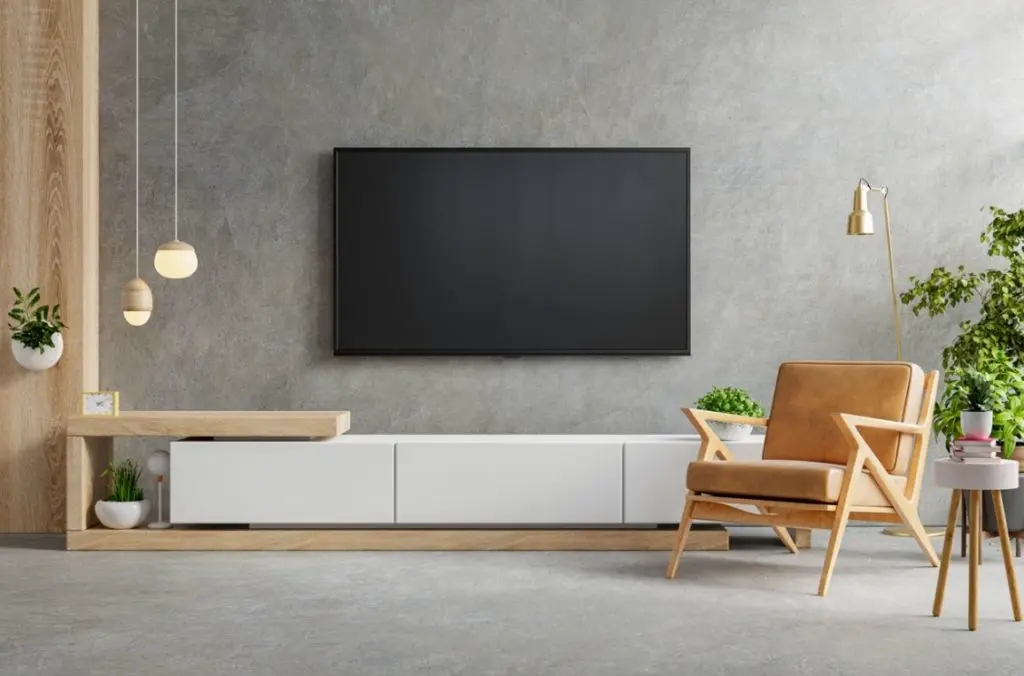
This cohesive approach to furniture selection and placement ensures that the living room remains functional, visually appealing, and clutter-free. By strategically incorporating multifunctional pieces and optimizing space usage, you can create a minimalist living room that is both practical and aesthetically pleasing.
Through this article, AIC JSC has shared with you the minimalist design for living room. From this, readers have recognized the importance of choosing a design and construction contractor. AIC JSC is a professional interior design and construction company. With rich experience and diverse projects, we are committed to delivering the highest quality and value to our customers. We guarantee project completion on time and provide warranty services. If you have any needs or require consultation, please do not hesitate to contact us. AIC JSC brings differentiation to customers, offering renowned interior design products known for their reliability, quality, and aesthetic appeal.
CONTACT: AIC – ARCHITECTURE & INTERIOR – CONSTRUCTION
𝐇𝐨𝐭𝐥𝐢𝐧𝐞: 090 633 02 88
𝐖𝐞𝐛𝐬𝐢𝐭𝐞: aicjsc.vn
Headquarters: No. 5 Hong Ha Street, Ward 2, Tan Binh District, Ho Chi Minh City.
𝐁𝐫𝐚𝐧𝐜𝐡 𝐨𝐟𝐟𝐢𝐜𝐞: 151/12 Thanh Xuan 21, Ward 6, Thanh Xuan District, Ward 12, Ho Chi Minh City.
Hanoi Branch: No. 20A, Hang Manh Street, Hang Gai Ward, Hoan Kiem District, Hanoi.
Danang Branch: Intersection of Nguyen Sinh Sac and Phu Thanh 7, Hoa Minh Ward, Lien Chieu District, Danang.
mục lục
Minimalist design for living room is gaining traction in 2024 as a popular trend in interior decoration. Embracing minimalism brings about an aura of elegance and comfort, creating an expansive and intelligently arranged space where the living room serves as the hub for family interaction and convergence. Join AIC JSC in exploring the latest ideas and approaches for minimalist living rooms in 2024
1. The concept of minimalist design
Minimalist design is a design philosophy that prioritizes simplicity, functionality, and the utilization of essential elements. Originating as an art movement in the early 20th century, it has since transcended various disciplines, including interior design, architecture, product design, and graphic design.
This design approach often defies fleeting trends, maintaining its relevance and allure over time. Its emphasis on simplicity, functionality, and quality ensures enduring aesthetic appeal.
Beyond aesthetics, minimalist spaces have a profound impact on well-being, promoting a sense of calm and reducing stress and anxiety. By minimizing clutter and emphasizing natural elements, they foster peace, tranquility, and overall wellness.
2. The core principles you should know about minimalist design for living room
Central to minimalist ideology is the notion of minimizing visual clutter. This entails making deliberate choices regarding furniture, decor, and overall design elements. The aim is to cultivate a space that exudes cleanliness, tidiness, and intentionality.
Moreover, Neutral Color Palette often serves as the cornerstone of minimalist design. Neutral Color Palette is commonly employed to instill a sense of serenity and expansiveness in the living room. While neutrals predominantly dictate the ambiance, sporadic pops of color can be introduced through accent pieces or organic accents to inject visual intrigue.
Furthermore, Clean Lines are imperative for achieving the desired minimalist aesthetic. Furniture characterized by sleek silhouettes and unblemished surfaces plays a pivotal role in maintaining simplicity and coherence within the space. Steer clear of excessively ornate or cumbersome pieces that could potentially inundate the room. The crisp, unadorned lines contribute significantly to the overall sense of refinement and lucidity inherent in minimalist design.
Lastly, it’s imperative to prioritize Quality over Quantity. Rather than inundating the living room with an excess of items, it’s advisable to invest in a select few high-quality, enduring pieces. This not only reinforces the minimalist aesthetic but also guarantees durability and sustainability in design choices. By prioritizing quality over quantity, one can curate a space that feels deliberate, refined, and thoughtfully composed.
3. Applying these principles to the minimalist design for living room
3.1 Utilizing Neutral Color Palettes as the Dominant Theme:
Choose neutral color palettes such as white, beige, and light gray as the dominant hues for walls, ceilings, and floors. These colors create a sense of spaciousness, openness, and bring elegance and lightness to the space. Complement these neutral tones with 1-2 contrasting or supplementary accent colors to create focal points in the room, such as blue, green, yellow, or orange.
However, avoid using too many colors in the same space, as it can make the room visually cluttered and detract from the minimalist beauty. Stick to hues that are relatively similar in brightness to maintain overall harmony in the design. For example:
Use light gray tones for walls and ceilings, combined with neutral colors like white and beige for furniture and decor.

Light gray with other neutral tones.
Use beige tones for walls and ceilings, paired with natural wood furniture such as oak or walnut.

Living room with beige walls and natural wood tones.
Incorporate accent colors like blue, green, yellow, or orange in materials and decorative accessories, but ensure they have a similar brightness level to the dominant neutral hues.

Living room with contrasting accent colors while maintaining harmony.
3.2 Utilizing natural materials:
Utilizing natural materials such as wood, stone, and metal can serve as exquisite focal points for various details within the living room, including the flooring, walls, ceiling, and furniture. These natural elements often exude an aura of sophistication and refinement, elevating the ambiance of the space. This harmonious blend creates a sense of unity and opulence, imparting a cohesive and luxurious feel to the living room.

Utilizing natural materials such as wood, stone, and metal
3.3 Harnessing natural light and employing warm-toned artificial lighting:
In minimalist design for living room design, harnessing natural light plays a pivotal role. Incorporating large windows allows ample natural light to flood the room, fostering a sense of openness and connection with the outdoors. Moreover, opting for sheer curtains enables precise control over light levels, offering flexibility to tailor the ambiance according to specific needs while maintaining a seamless integration with the space.
 Beyond leveraging natural light, artificial lighting choices are equally paramount. Recessed LED lights and floor lamps should emit warm-toned hues, fostering a cozy and relaxing atmosphere. Avoiding overly harsh lighting not only safeguards eye health but also ensures the living room remains inviting and comfortable. Seamless transitions between natural and artificial light sources further enhance the overall aesthetic appeal, creating a harmonious and tranquil environment conducive to relaxation and socializing.
Beyond leveraging natural light, artificial lighting choices are equally paramount. Recessed LED lights and floor lamps should emit warm-toned hues, fostering a cozy and relaxing atmosphere. Avoiding overly harsh lighting not only safeguards eye health but also ensures the living room remains inviting and comfortable. Seamless transitions between natural and artificial light sources further enhance the overall aesthetic appeal, creating a harmonious and tranquil environment conducive to relaxation and socializing.

3.4 Limiting the Use of Ornate Decor:
In the principle of minimalist design for living room, restricting ornate decorations and focusing on essential details is crucial. Instead of overcrowding the space, we should concentrate on necessary items such as artworks, vases of flowers, and lamps to create focal points and highlight the space. Decorative items should be carefully chosen with simple, elegant designs that complement the overall style of the room. The use of greenery not only brings fresh air but also creates a natural connection. Avoid overloading the space by keeping the amount of decor to a minimum, helping maintain openness and harmony.

3.5 Prioritize the Use of Simple, Neat Furniture.
Utilizing simple, tidy furniture with high functionality is the key to minimalist design for living room. This approach ensures that each item contributes meaningfully to the space without overwhelming it. Prioritizing multifunctional furniture is essential, as it maximizes utility while minimizing the need for excessive pieces. Examples include sofa beds or storage ottomans, which serve multiple purposes and help declutter the living room, creating a more spacious feel.
Consider wall-mounting the TV console or opting for a low-profile stand to save space in the living room. By elevating the TV console or choosing a compact design, you can maximize floor space and create an open and airy environment. Additionally, look for consoles with integrated storage options to keep media equipment and accessories organized and out of sight.

This cohesive approach to furniture selection and placement ensures that the living room remains functional, visually appealing, and clutter-free. By strategically incorporating multifunctional pieces and optimizing space usage, you can create a minimalist living room that is both practical and aesthetically pleasing.
Through this article, AIC JSC has shared with you the minimalist design for living room. From this, readers have recognized the importance of choosing a design and construction contractor. AIC JSC is a professional interior design and construction company. With rich experience and diverse projects, we are committed to delivering the highest quality and value to our customers. We guarantee project completion on time and provide warranty services. If you have any needs or require consultation, please do not hesitate to contact us. AIC JSC brings differentiation to customers, offering renowned interior design products known for their reliability, quality, and aesthetic appeal.
CONTACT: AIC – ARCHITECTURE & INTERIOR – CONSTRUCTION
𝐇𝐨𝐭𝐥𝐢𝐧𝐞: 090 633 02 88
𝐖𝐞𝐛𝐬𝐢𝐭𝐞: aicjsc.vn
Headquarters: No. 5 Hong Ha Street, Ward 2, Tan Binh District, Ho Chi Minh City.
𝐁𝐫𝐚𝐧𝐜𝐡 𝐨𝐟𝐟𝐢𝐜𝐞: 151/12 Thanh Xuan 21, Ward 6, Thanh Xuan District, Ward 12, Ho Chi Minh City.
Hanoi Branch: No. 20A, Hang Manh Street, Hang Gai Ward, Hoan Kiem District, Hanoi.
Danang Branch: Intersection of Nguyen Sinh Sac and Phu Thanh 7, Hoa Minh Ward, Lien Chieu District, Danang.
Minimalist design for living room is gaining traction in 2024 as a popular trend in interior decoration. Embracing minimalism brings about an aura of elegance and comfort, creating an expansive and intelligently arranged space where the living room serves as the hub for family interaction and convergence. Join AIC JSC in exploring the latest ideas and approaches for minimalist living rooms in 2024
1. The concept of minimalist design
Minimalist design is a design philosophy that prioritizes simplicity, functionality, and the utilization of essential elements. Originating as an art movement in the early 20th century, it has since transcended various disciplines, including interior design, architecture, product design, and graphic design.
This design approach often defies fleeting trends, maintaining its relevance and allure over time. Its emphasis on simplicity, functionality, and quality ensures enduring aesthetic appeal.
Beyond aesthetics, minimalist spaces have a profound impact on well-being, promoting a sense of calm and reducing stress and anxiety. By minimizing clutter and emphasizing natural elements, they foster peace, tranquility, and overall wellness.
2. The core principles you should know about minimalist design for living room
Central to minimalist ideology is the notion of minimizing visual clutter. This entails making deliberate choices regarding furniture, decor, and overall design elements. The aim is to cultivate a space that exudes cleanliness, tidiness, and intentionality.
Moreover, Neutral Color Palette often serves as the cornerstone of minimalist design. Neutral Color Palette is commonly employed to instill a sense of serenity and expansiveness in the living room. While neutrals predominantly dictate the ambiance, sporadic pops of color can be introduced through accent pieces or organic accents to inject visual intrigue.
Furthermore, Clean Lines are imperative for achieving the desired minimalist aesthetic. Furniture characterized by sleek silhouettes and unblemished surfaces plays a pivotal role in maintaining simplicity and coherence within the space. Steer clear of excessively ornate or cumbersome pieces that could potentially inundate the room. The crisp, unadorned lines contribute significantly to the overall sense of refinement and lucidity inherent in minimalist design.
Lastly, it’s imperative to prioritize Quality over Quantity. Rather than inundating the living room with an excess of items, it’s advisable to invest in a select few high-quality, enduring pieces. This not only reinforces the minimalist aesthetic but also guarantees durability and sustainability in design choices. By prioritizing quality over quantity, one can curate a space that feels deliberate, refined, and thoughtfully composed.
3. Applying these principles to the minimalist design for living room
3.1 Utilizing Neutral Color Palettes as the Dominant Theme:
Choose neutral color palettes such as white, beige, and light gray as the dominant hues for walls, ceilings, and floors. These colors create a sense of spaciousness, openness, and bring elegance and lightness to the space. Complement these neutral tones with 1-2 contrasting or supplementary accent colors to create focal points in the room, such as blue, green, yellow, or orange.
However, avoid using too many colors in the same space, as it can make the room visually cluttered and detract from the minimalist beauty. Stick to hues that are relatively similar in brightness to maintain overall harmony in the design. For example:
Use light gray tones for walls and ceilings, combined with neutral colors like white and beige for furniture and decor.

Light gray with other neutral tones.
Use beige tones for walls and ceilings, paired with natural wood furniture such as oak or walnut.

Living room with beige walls and natural wood tones.
Incorporate accent colors like blue, green, yellow, or orange in materials and decorative accessories, but ensure they have a similar brightness level to the dominant neutral hues.

Living room with contrasting accent colors while maintaining harmony.
3.2 Utilizing natural materials:
Utilizing natural materials such as wood, stone, and metal can serve as exquisite focal points for various details within the living room, including the flooring, walls, ceiling, and furniture. These natural elements often exude an aura of sophistication and refinement, elevating the ambiance of the space. This harmonious blend creates a sense of unity and opulence, imparting a cohesive and luxurious feel to the living room.

Utilizing natural materials such as wood, stone, and metal
3.3 Harnessing natural light and employing warm-toned artificial lighting:
In minimalist design for living room design, harnessing natural light plays a pivotal role. Incorporating large windows allows ample natural light to flood the room, fostering a sense of openness and connection with the outdoors. Moreover, opting for sheer curtains enables precise control over light levels, offering flexibility to tailor the ambiance according to specific needs while maintaining a seamless integration with the space.
 Beyond leveraging natural light, artificial lighting choices are equally paramount. Recessed LED lights and floor lamps should emit warm-toned hues, fostering a cozy and relaxing atmosphere. Avoiding overly harsh lighting not only safeguards eye health but also ensures the living room remains inviting and comfortable. Seamless transitions between natural and artificial light sources further enhance the overall aesthetic appeal, creating a harmonious and tranquil environment conducive to relaxation and socializing.
Beyond leveraging natural light, artificial lighting choices are equally paramount. Recessed LED lights and floor lamps should emit warm-toned hues, fostering a cozy and relaxing atmosphere. Avoiding overly harsh lighting not only safeguards eye health but also ensures the living room remains inviting and comfortable. Seamless transitions between natural and artificial light sources further enhance the overall aesthetic appeal, creating a harmonious and tranquil environment conducive to relaxation and socializing.

3.4 Limiting the Use of Ornate Decor:
In the principle of minimalist design for living room, restricting ornate decorations and focusing on essential details is crucial. Instead of overcrowding the space, we should concentrate on necessary items such as artworks, vases of flowers, and lamps to create focal points and highlight the space. Decorative items should be carefully chosen with simple, elegant designs that complement the overall style of the room. The use of greenery not only brings fresh air but also creates a natural connection. Avoid overloading the space by keeping the amount of decor to a minimum, helping maintain openness and harmony.

3.5 Prioritize the Use of Simple, Neat Furniture.
Utilizing simple, tidy furniture with high functionality is the key to minimalist design for living room. This approach ensures that each item contributes meaningfully to the space without overwhelming it. Prioritizing multifunctional furniture is essential, as it maximizes utility while minimizing the need for excessive pieces. Examples include sofa beds or storage ottomans, which serve multiple purposes and help declutter the living room, creating a more spacious feel.
Consider wall-mounting the TV console or opting for a low-profile stand to save space in the living room. By elevating the TV console or choosing a compact design, you can maximize floor space and create an open and airy environment. Additionally, look for consoles with integrated storage options to keep media equipment and accessories organized and out of sight.

This cohesive approach to furniture selection and placement ensures that the living room remains functional, visually appealing, and clutter-free. By strategically incorporating multifunctional pieces and optimizing space usage, you can create a minimalist living room that is both practical and aesthetically pleasing.
Through this article, AIC JSC has shared with you the minimalist design for living room. From this, readers have recognized the importance of choosing a design and construction contractor. AIC JSC is a professional interior design and construction company. With rich experience and diverse projects, we are committed to delivering the highest quality and value to our customers. We guarantee project completion on time and provide warranty services. If you have any needs or require consultation, please do not hesitate to contact us. AIC JSC brings differentiation to customers, offering renowned interior design products known for their reliability, quality, and aesthetic appeal.
CONTACT: AIC – ARCHITECTURE & INTERIOR – CONSTRUCTION
𝐇𝐨𝐭𝐥𝐢𝐧𝐞: 090 633 02 88
𝐖𝐞𝐛𝐬𝐢𝐭𝐞: aicjsc.vn
Headquarters: No. 5 Hong Ha Street, Ward 2, Tan Binh District, Ho Chi Minh City.
𝐁𝐫𝐚𝐧𝐜𝐡 𝐨𝐟𝐟𝐢𝐜𝐞: 151/12 Thanh Xuan 21, Ward 6, Thanh Xuan District, Ward 12, Ho Chi Minh City.
Hanoi Branch: No. 20A, Hang Manh Street, Hang Gai Ward, Hoan Kiem District, Hanoi.
Danang Branch: Intersection of Nguyen Sinh Sac and Phu Thanh 7, Hoa Minh Ward, Lien Chieu District, Danang.

